MEDICINAL PLANT
 rimitive humans experimentally sampled many kinds of plants in their search for nourishment. Plants that were palatable were used for food; those with toxic or unpleasant effects were avoided or used against enemies; others that produced physiological effects such as perspiration, defecation, healing, or hallucination were saved for medicinal purposes and divination. Over a period of thousands of years, people learned to use a variety of plants as medicines for different ailments.
rimitive humans experimentally sampled many kinds of plants in their search for nourishment. Plants that were palatable were used for food; those with toxic or unpleasant effects were avoided or used against enemies; others that produced physiological effects such as perspiration, defecation, healing, or hallucination were saved for medicinal purposes and divination. Over a period of thousands of years, people learned to use a variety of plants as medicines for different ailments.
Use in History
Over 4,000 years ago, according to tradition, the Chinese emperor Chi'en Nung put together a book (herbal) of medicinal plants called Pen Tsao. It contained descriptions of more than 300 plants, several of which are still used in medicine. During the same era and later, the Sumerians recorded prescriptions on clay tablets, while the Egyptians recorded exotic plant ingredients in Ebers Papyrus. The Greeks and the Romans derived some of their herbal knowledge from these early civilizations. Their contributions are recorded in De Materia Medica by Dioscorides and the 37-volume natural history written by Pliny the Elder. Some of these earlier works are known to us through translations into Arabic by Rhazes and Avicenna. The knowledge of medicinal plants was further nurtured by monks in Europe who studied and grew medicinal plants and translated the Arabic works.
The first "licensed" apothecary shops opened in Baghdad (now in Iraq) in the 9th century. By the 13th century, London became a major trading center in herbs and spices. Much adulteration occurred in this trade, because proper standards and quality controls had not been established. Poorly identified plants and substitutes for true medicinal herbs were sold everywhere. In 1753, Carolus Linnaeus introduced the binomial system of plant nomenclature, which helped in the identification of plants. With the subsequent publication of pharmacopoeias, the method of identification and the standard of quality for each drug was clearly defined.
The present trend to replace crude plant drugs with their pure active principles started with the pioneering work in the 18th century of Karl Scheele, who isolated organic acids from plants. This achievement was followed by the isolation of morphine from opium by Friedrich Serturner and quinine from cinchona bark by Pierre Pelletier and Joseph Caventou. These and similar discoveries opened the door to the field of phytochemistry. Today a vast number of modern drugs are still derived from natural sources; approximately 25% of all prescriptions contain one or more active ingredients from plants.
Active Ingredients
Numerous familiar examples can be given. The active ingredient in the toxic plants used in South America to poison arrow tips is curare, now used as a skeletal muscle relaxant in surgery. The opium poppy, praised by the Babylonians for its medicinal value, produces morphine, an indispensable analgesic. Coca, the divine plant of the Incas, yields cocaine, a useful local anesthetic. The drug LSD (lysergic acid diethylamide) is chemically related to compounds obtained from the fungus ergot, which yields useful substances, some of which stop bleeding in childbirth or relieve migraine headaches.
Some plants of the nightshade family, Solanaceae, such as the species of Datura and Atropa, contain fairly large amounts of the poisonous alkaloids atropine and scopolamine (the latter sometimes called hyoscine). These plants are toxic when consumed in large quantity but are invaluable medicinal agents when administered in proper amounts. The Chibcha Indians of Colombia, South America, used a variety of Datura species to sedate their human sacrifices; several tribes in Africa continue to use it in initiation rites. In Jamestown, Va., in 1676, British troops sent to quell Bacon's Rebellion ate Datura plants for greens, with massively intoxicating effects. The plant, Datura stramonium, was then named Jamestown weed, which was later shortened to the familiar jimsonweed. The juice of the belladonna plant, Atropa belladonna, whose name in Italian means beautiful lady, was used by women in centuries past to dilate, or widen, the pupils of the eyes, a sign of beauty in those days. The active principle atropine is employed in modern medicine as a mydriatic (pupil dilator); scopolamine is used as a hypnotic and as an antispasmodic to reduce gastrointestinal contractions.

Foxglove, Digitalis purpurea, a common garden plant, was first described by Dioscorides but did not become popular as a drug until an 18th-century English physician, William Withering, brought to light its usefulness in treating dropsy. Dropsy often occurs in patients with congestive heart failure, and in modern medicine digitalis is the drug of choice for treating patients with this ailment.
The snakeroot, Rauvolfia serpentina, belonging to the dogbane family, Apocynaceae, has been used in India for centuries in folk medicine for the treatment of mental disease and insomnia, as a sedative in snakebites, and for many other purposes. Its potential as a drug was not taken seriously by modern medicine until 1949, when R. Vakil published his results on the use of Rauvolfia in hypertension (high blood pressure). The active ingredient was found to be an alkaloid, named reserpine, now used in treating a variety of psychiatric disorders and hypertension. In a way Rauvolfia heralded the era of tranquilizers. The Madagascar periwinkle, Catharanthus roseus, which belongs to the same family as Rauvolfia, was investigated for its supposed ability to cure diabetes. Research revealed that plant extracts had little hypoglycemic, or blood-sugar-reducing, activity but did produce leukopenia, or an abnormally low number of white blood cells, in laboratory animals. Further studies led to the isolation of vinblastine and vincristine, which are alkaloids now used in treating Hodgkin's disease and childhood leukemia, respectively.
When cortisone and other steroids, such as the sex hormones, were first isolated in the 1930s in minute amounts from glands of cattle, their usefulness as medicinal agents was apparent, but the cost of isolating them was prohibitive. Because the supply from animal sources was inadequate, a worldwide search for plant substitutes was undertaken. This search led to a variety of yams, Dioscorea, which now provide the starting material, diosgenin, for the production of several steroids.
Rustem S. Medora
Bibliography: Bensky, Dan, et al., Chinese Herbal Medicine (1986); Craker, L. E., and Simon, J. E., eds., Herbs, Spices and Medicinal Plants (1986); Hooper, Madge, Herbs and Medicinal Plants (1986); Meyer, G. G., et al., Folk Medicine and Herbal Healing (1981); Morton, J. F., Major Medicinal Plants (1977); Taylor, Norman, Plant Drugs that Changed the World (1965).
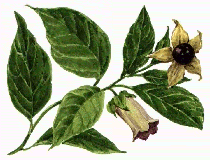
Belladonna, or deadly nightshade, Atropa belladonna, is a poisonous plant of the potato family, Solanaceae. Native to Europe and Anatolia, it is a herbaceous perennial that grows from a creeping rootstock to a height of 1.5 m (5 ft). The leaves are oval in outline, have smooth edges, and are positioned singly along the stem; the solitary, purplish flowers are bell-shaped and nodding, about 2.5 cm (1 in) long, and upon maturity produce a brownish or blackish berry about the size of a cherry. All parts of the plant contain poisonous chemicals, called ALKALOIDS, but the berries are most often responsible for poisoning in humans, especially children. The leaves and roots contain ATROPINE, which is used as an antispasmodic in treating asthma and hyperacidity. Charles H. Styer
See also: MEDICINAL PLANTS.
Butterfly weed, Asclepias tuberosa, is a plant in the milkweed family, Asclepiadaceae, with a brilliant orange and yellow flower. It lives in dry open soils in North America and is one of the few milkweeds without a milky juice. The brilliant colors of the flowers attract butterflies. Another common name for butterfly weed is pleurisy root, since it was used to treat lung and throat ailments. The scientific name refers to the Greek god of medicine, Asclepius.
Comfrey {kuhm'-free} is the common name of perennial herbs in the genus Symphytum, family Boraginaceae. Common comfrey, S. officinale, was introduced into the eastern United States from Europe as a medicinal herb. It grow to heights of about 1 m (3 ft) and has hairy leaves and small, yellowish white to pink and purplish flowers.
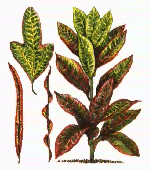
Croton {kroh'-tuhn} is the common name for plants of genera Codiaeum and Croton in the spurge family, Euphorbiaceae. Members of the highly colored Codiaeum genus are tropical shrubs. Combinations of yellow, green, red, pink, and purple are found in their leaves. Most of the many garden and houseplant varieties were originally selections from C. variegatum, variety pictum. All members of the large tropical and subtropical genus Croton are trees. Croton oil, a purgative, is extracted from C. tiglium, and C. eluteria yields cascarilla bark, which also has medicinal value.
Charles L. Wilson
The figwort {fig'wurt} family, Scrophulariaceae, contains about 3,000 species of herbs, shrubs, and trees found worldwide. This family contains many medicinal plants, such as FOXGLOVE, the source of the heart drug DIGITALIS, as well as flowering plants like the SNAPDRAGON. The genus Scrophularia contains about 200 species of strong-smelling herbs native to the Northern Hemisphere and named for their supposed medicinal usefulness in cases of scrofula, tuberculosis of the lymph nodes. Maryland figwort, S. marilandica, is found from Maine to Georgia and produces greenish purple flowers in mid-summer.
Foxglove is the common name for about 20 to 30 species of summer-flowering biennial or short-lived perennial herbs in the genus Digitalis, family Scrophulariaceae. They are native to Europe and northwest Africa to central Asia. The common foxglove, D. purpurea, grows to a height of 150 cm (5 ft). Its leaves are alternate, lance-shaped, up to 30 cm (1 ft) long, and hairy above with soft white hairs below. Leaves are tapered at the base to form winged stalks. The flowers droop and are arranged on erect racemes, and its fruit are capsules containing numerous seeds.
Common foxglove is found in clearings, in burned areas, and in hilly dry pastures, and it is often grown as an ornamental. Many varieties have been originated through breeding, with flowers varying from white to a deep rose color. The dried leaves, the source of the drug DIGITALIS used for heart trouble, have been used medicinally since as early as the 13th century. Because a single hectare can yield hundreds of kilograms of dried leaves, only a few hundred hectares of land are required to meet the demand for digitalis in medicine. K. B. Paul
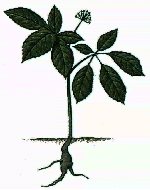
Ginseng {jin'-seng} is a perennial herb of the genus Panax, in the family Araliceae. Asiatic ginseng, P. pseudoginseng, is native to eastern Asia. Wild American ginseng, P. quinquefolius, is native to eastern woodlands. It stands up to 60 cm (2 ft) tall, has leaves up to 15 cm (6 in) long, and bears greenish white flowers. Dwarf ginseng, P. trifolus, is a smaller American species.
The root of the ginseng has for centuries been reputed to be a panacea for cancer, rheumatism, diabetes, sexual debility, and aging. The claims date back to ancient China, and the root was long of great value there; Europe did not hear of it until 1642, when the explorer Alvaro Samedo returned with a report of the restorative properties of Oriental ginseng, which he claimed was being sold for twice its weight in silver.
In 1713, Emile Jartoux, a Jesuit cartographer working in northern China, reported ginseng's effectiveness and power among the Chinese. Another Jesuit, Joseph Francois Lafiteau, read the report in Quebec, and after a diligent search found (1718) in the woods near his mission an almost identical species, American ginseng. Demand for the American root grew in China, and many colonists and settlers, including Daniel Boone, hunted it avidly. Millions of pounds were uprooted, dried, and exported in the China trade. Eventually the slow-maturing plant was almost extinct. Cultivation began in the late 19th century, but the Chinese market balked at the cultivated American product, and many investments were lost.
Today China and Korea export ginseng to the West, where its popularity has grown in recent years. Russian scientists claim to have found substances in ginseng that stimulate endocrine secretions and act as a tonic to the cardiovascular system. Medical research in the West, however, has failed to substantiate these claims.
Bibliography: Curran, D. F., The Complete Ginseng Grower's Manual (1983, repr. 1989); Fulder, S., The Book of Ginseng: Chinese Herbs for Immune Power (1993); Harding, A. R., Ginseng and Other Medicinal Plants, rev. ed. (1991).
Henbane {hen'-bayn} is the common name for about 15 plant species comprising the genus Hyoscyamus of the NIGHTSHADE family, Solanaceae. They are native from central Asia through much of Europe to northern Africa. All parts of the plant have long been known to be poisonous. Henbane was used as an anesthetic from early Greek times to the Middle Ages and was sometimes smoked to relieve the pain of toothache. Seeds and leaves yield three ALKALOID drugs: hyoscyamine, ATROPINE, and SCOPOLAMINE. Black henbane, H. niger, is the most commonly cultivated species. It is a coarse biennial or annual with foul-smelling, hairy, sticky leaves. The annual grows to 60 cm (2 ft) in height and bears yellow, funnel-shaped flowers; the biennial grows up to 1 m (3 ft), and the yellow flowers have purple veins. Arthur O. Tucker
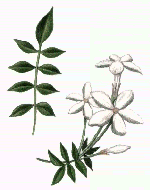
Essential oils are aromatic substances produced by certain plants. Most of these oils, which are extracted, concentrated, and used as perfume scents or food flavorings, have been known since ancient times. They are called essential because it was thought that each oil represented the essence of the plant from which it was obtained. Chemically complex, they are a mixture of organic compounds, primarily terpenes.
There are some 200 commercially produced essential oils, all obtained from the oil-bearing leaves, flowers, bark, seeds, or wood of aromatic plants. Steam distillation is the most common method of extraction, particularly for oils from seeds or bark. In this process, hot steam is passed over the plant tissues, and the volatile compounds evaporate and are then condensed in water. Citrus oils are expressed from the flavor sacs in the rind of the fruits. Some flower petals, whose oils are destroyed by steam processing, are treated by the slow process of enfleurage: the blossoms are placed on a layer of cold fat, which absorbs the oil; fresh blossoms are added until the fat is completely oil saturated; and the resulting substance, called a pomade, is washed with alcohol to remove the oil. In France, where enfleurage is used to extract such essences as tuberose and jasmine, the process involves as many as 36 separate additions of fresh flower petals; the most saturated pomade is therefore called Pomade 36.
All essential oils are soluble in alcohol, and flavoring extracts, such as oil of cloves, vanilla, and the oils from citrus fruits, are usually sold as alcohol solutions.
With the exception of pine oil and oil of turpentine, which are manufactured in great volume, essential oils are produced in relatively small quantities. (It requires, for instance, some 3,500-4,000 pounds of rose petals to distill one ounce of attar of rose.) The high cost of many of these oils has prompted a search for synthetic substitutes. For a few essential oils, chemists have succeeded in isolating and synthesizing the single molecule that provides the characterizing aroma, but without the complex mixture of constituents--sometimes, several hundred in a single oil--the quality and depth of the aroma of any natural oil has yet to be duplicated.
See also: FATS AND OILS; FLAVORS AND FRAGRANCES; HERBS AND SPICES.
Lungwort is the common name for herbaceous plants of the genus Pulmonaria, family Boraginaceae, and a LICHEN (tree lungwort, Lobaria pulmonaria) that were formerly used in treating lung diseases. Pulmonaria species are garden flowers common in Europe; their drooping pink flowers turn blue, and their leaves are covered with stiff hairs.
Mandrake, Mandragora officinarum, is an old European medicinal plant of the nightshade family, Solanaceae. Because its thick root is often forked, suggesting human legs, and frequently has additional side roots, appearing to be arms, many superstitions have been associated with the mandrake. The roots contain the alkaloid hyoscyamine, which can interfere with the transmission of nerve impulses, and were used in many folk remedies.
Mandrake is a perennial herb with long, wavy-margined leaves arising from the rootstock and large, bell-shaped, greenish yellow or purplish flowers borne in the center of the leaves. The flowers mature into fleshy berries once thought to have aphrodisiac properties.
In North America the perennial herb Podophyllum peltatum, of the barberry family, Berberidaceae, commonly called the Mayapple, sometimes has a divided rootstock and has also been known as a mandrake.
Nightshade is the common name for a family of plants, Solanaceae, and particularly for the plants of one of its genera, Solanum. The genus Solanum comprises about 1,700 species of widely distributed annual and perennial herbs, many shrubs, and some trees. Poisonous alkaloids are present in many of these plants, including the common potato, S. tuberosum, which is perfectly safe to eat if cooked.
The common, or black, nightshade, S. nigrum, native to Europe but now widespread elsewhere, is an annual, weak-stemmed plant that may be prostrate or erect and grow to 75 cm (2.5 ft) in length. It has long-stalked, irregularly margined leaves and small white flowers with turned-back petals. Its fruit is a black berry. The common nightshade is often reported to be a poisonous plant, but it is sometimes cooked as a pot herb and its ripe, not green, berries are sometimes made into pies or preserves. The bitter nightshade, S. dulcamara, is native to Eurasia but now grows wild in North America. In Europe it is often called the bittersweet, but it should not be confused with the American bittersweet, Celastrus. The leaves of the bitter nightshade are pointed and usually have two narrow lobes at the base. The flowers are small and violet in color, with turned-back petals and beaklike anthers. The oval berries, about 1 cm (0.4 in) long, are borne in drooping clusters and ripen into a brilliant red color. All parts of the plant, particularly the berries and the leaves on new shoots, are poisonous. The related deadly nightshade, or BELLADONNA, Atropa belladonna, is cultivated for medicinal purposes.
Bibliography: Childers, Norman F., and Russo, Gerard M., Nightshades and Health (1977); Hooper, Madge, Hergs and Medicinal Plants (1986); Williams, Trevor I., Drugs from Plants (1980).
Rauwolfia {row-wul'-fee-uh} , Rauvolfia serpentina, is a plant of the DOGBANE family, Apocynaceae. Native to India, Sri Lanka, and Indonesia, the low-growing evergreen plant is known there as snakeroot for its snakelike roots. Rauwolfia has been used in folk medicine for centuries and, more recently, as a source of the medicinal alkaloid RESERPINE. Larry C. Higgins
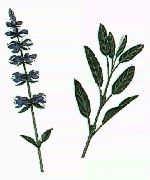
Salvia {sal'-vee-uh} is the generic name for sage and encompasses about 700 herbaceous, shrublike species of plants belonging to the mint family, Labiatae. The genus includes several ornamental, culinary, and medicinal species of herbs. The stem of these plants is squarish, and the leaves grow opposite to each other along a branch.
The common sage, S. officinalis, native to the Mediterranean region, is grown commercially and in home gardens for its rough-textured, woolly leaves. These aromatic leaves, either fresh or dried, are used to flavor such meats as pork and sausage, cheese, and poultry seasoning. An essential oil made from the leaves is used to flavor food, beverages, and perfumes. Sage tea has long been believed to be a spring tonic, increasing circulation, improving memory, and promoting longevity. Another medicinal herb, known as clary, S. sclarea, produces broad leaves and lilac-colored flowers. In past centuries it was used in eyewashes to reduce inflammation.
An ornamental salvia from Brazil, scarlet sage, S. splendens, is often grown in flower gardens and borders for its vivid scarlet blooms, which are arranged in spikes. These flowers appear from early summer to fall. Two other ornamental salvias are S. farinacea, which has deep violet blue flowers and is grown as bedding, and gentian sage, S. patens, with bright blue flowers and arrow-shaped leaves.
Sarsaparilla {sas-puh-ril'-uh} is an aromatic extract from the roots of several species of tropical vines of the genus Smilax of the lily family, Liliaceae. It was once employed as a tonic and as a treatment for rheumatism and is now used to flavor medicines and soft drinks. Sarsaparilla plants--large perennial vines with short, thick, underground stems--are native to tropical America and grow in jungles from Mexico to Peru. Sarsaparilla (Spanish zarza, "bramble," and parrilla, "little vine") was introduced into Europe as a medicinal in the 1500s.
The roots of the harvested sarsaparilla plant are sun-dried and tied in bundles for export. A liquid extract from the roots is used for flavoring, and the chemical sarsapogenin--isolated from the sarsaparilla root--is used to synthesize such steroids as progesterone. The North American wild sarsaparilla, Aralia nudicaulis, and false sarsaparilla, A. hispida, are so-called because their extracts are sometimes used as substitutes in flavoring. Frances Gies
Snakeroot, or serpentaria, is the common name for any of several plants, including white snakeroot, Eupatorium urticoefolium. A bitter tea made from the root of these plants was formerly used as a tonic and even earlier was used as a folk medicine to treat snakebite. No known constituents of the root, however, have any beneficial effect against snake venom. Richard H. Runser
Spikenard {spyk'-nahrd} is the common name for a Himalayan plant, Nardostachys jatamansii, of the valerian family, Valerianaceae. An essential oil used in ointments and in perfumery is obtained by distillation of the aromatic root. The American spikenard, Aralia racemosa, of the ginseng family, Araliaceae, is a plant native to the eastern United States. A decoction of the root was used by Indians for backache, rheumatoid arthritis, and coughing. Another plant of eastern North America, Smilacina racemosa, of the lily family, Liliaceae, is sometimes known as wild spikenard.
Kenneth R. Robertson
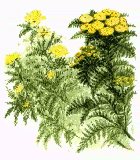
Tansy {tan'-zee} is the common name for about 50 species of annual or perennial herbs of the genus Tanacetum, family Compositae. Common tansy, T. vulgare, has a pungent odor and aromatic juice, which is used as a flavoring but can be toxic in high doses. The dried leaves once were used for medicinal purposes.
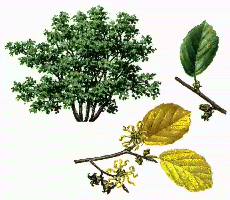
Witch hazel is the common name for about 100 species of trees and shrubs in the family Hamamelidaceae but is most commonly applied to Hamamelis virginiana. This shrub or small tree is usually found in moist soils along streams from New Brunswick to Iowa and south to Arkansas and Florida, where it may grow up to 9 m (30 ft) tall.
Leaves are alternate with widely spaced marginal teeth and grow up to 15 cm (6 in) long and 8 cm (3 in) wide. Foliage is a dull green above and lighter below, with hair on the midrib and veins.
Flowers are yellow with thin elongated petals and produce a two-valved, woody capsule that splits and ejects the black seeds when mature.
The common name is derived from the medicinal properties of the alcoholic extract from the leaves and bark of the plant, which is used on bruises and inflammations and as a rubbing lotion.
_Copyright (c) Grolier Electronic Publishing, Inc._
THANKS FOR VISITING! GOD BLESS YOU!
